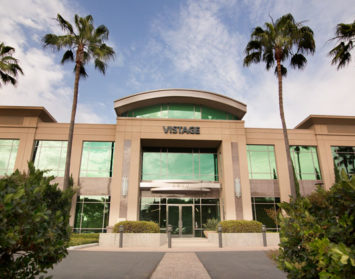By Thor Biberman
As recently as nine months ago, large tenants scouting out space along the Interstate 15 Corridor had a wide range of choices.
With a notable exception, it’s not so much the case anymore, according to panelists at a meeting on opportunities for tenants along the corridor that was held Thursday at the Sabre Springs Corporate Center.
 Scot Ginsburg, a tenant specialist, said whereas Rancho Bernardo’s Class A vacancy may have been in the mid-20 percent ranges (or even higher by some accounts) at mid-year in 2010, the rate is much closer to 8 percent today and may end up being closer to 6 percent by the end of 2011.
Scot Ginsburg, a tenant specialist, said whereas Rancho Bernardo’s Class A vacancy may have been in the mid-20 percent ranges (or even higher by some accounts) at mid-year in 2010, the rate is much closer to 8 percent today and may end up being closer to 6 percent by the end of 2011.
CoStar, incidentally pegged the I-15 Corridor with a year-end Class A vacancy of about 10.2 percent.
Nokia (NYSE: NOK), which once had more than 300,000 square feet in the Scripps Northridge project overlooking Sabre Springs, went into about 190,000 square feet in the Summit in Rancho Bernardo last fall, leaving what is still a 300,000-square-foot hole at Scripps Northridge.
Ginsburg said he currently negotiating with an unidentified tenant that could conceivably take 150,000 to 200,000 square feet of that space, but the deal hasn’t been signed.
Also in Rancho Bernardo within the past few months, Broadcom (Nasdaq: BRCM) added 90,000 square feet to its Discovery Corporate Center location, Northrop Grumman (NYSE: NOC) went into 93,000 square feet at The Point and Palomar College paid $38.3 million for the 110,000-square-foot Bernardo Terrace office building.
Hitachi Data Systems also last year went into 50,000 square feet of space that Accredited Home Lenders formerly occupied, along Carmel Mountain Road.
“If you need a space of more than 50,000 square feet, there aren’t a lot of options,” Ginsburg said.
Ginsburg noted that by the time Nokia, Broadcom and Northrop Grumman were signing their transactions, the rents had dropped 30 to 40 percent from their peak in 2006.
“Class A space along the corridor was $3-per-square foot in 2008. It got down as low as $2, but should be ratcheting back up to $2.50-per-square-foot by the end of the year,” Ginsburg said.
“Landlords will start to micromanage and you will see rents rising quickly,” he said.
For now, Ginsburg said it is still possible for an existing tenant to get bargains on rent.
He added that the tenant also needs to begin negotiations a year before the lease expiration date so the lessee isn’t forced to stay in a building it might not want.
While the landlord might be able to get a $2.50 rate by holding out for another tenant, he or she might also decide that its better to get $1.60 and not have an empty building.
With still very affordable lease rates, Ginsburg said Class A space along the corridor is being gobbled up, while the Class B market has proven to be more difficult to lease.
“The Class B downtime is about 18 months in this market,” Ginsburg added.
CoStar said while the 2010 year-end Class A vacancy was 10.2 percent — a figure that Ginsburg said has continued to decline — the Class B space along the corridor was 24.1 percent vacant at the year’s end.
Existing tenants are still in the drivers’ seat.
Ginsburg said while the tenant improvement costs for the landlord might be $7-per-square-foot for an existing tenant, the cost for a replacement tenant may be $20-per-square-foot.
Other concessions along the I-15 Corridor may still favor the tenant more than they have in years.
While one month per year of the lease term had been typical when the economy was stronger, Ginsburg said he has seen deals as generous as 10 months free on a five-year lease.
While these dynamics continue to favor the tenant, Scott Biel, a Mintz Levin partner, warned that the window of opportunity for tenants, particularly large ones, appears to be closing.
Biel said generally, the leasing market along the I-15 Corridor will still be in the tenant’s favor for the remainder of this year, neutral in 2012, and in the landlord’s favor in 2013 and 2014.
Ginsburg added that there are always going to be reasons for staying or leaving.
“Don’t be afraid to move in this market. It is sometimes cheaper. You can still get a boatload of free rent,” Ginsburg said.
“Remember, the costs of subletting a space can be substantial,” Biel added.
Biel noted that moving is often a necessity if a business needs 10,000-square feet of expansion space that just isn’t there.
Whatever the deal, Biel added that tenants need to know the landlord’s fiscal health.
“If a building goes into foreclosure, it could wipe out your lease,” Biel said, adding that he knows of cases where buildings have been foreclosed on and tenants have been put out into the street in favor of higher-paying lessees.
“In industrial buildings I have seen this happening quite a bit,” Biel said.
Ginsburg has also seen the phenomenon.
“And the big boys have no qualms about walking away,” he said.
Scot Ginsburg is an executive vice president of Hughes Marino, a global corporate real estate advisory firm that exclusively represents tenants and buyers. Contact Scot at 1-844-662-6635 or scot.ginsburg@hughesmarino.com to learn more.








